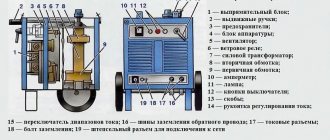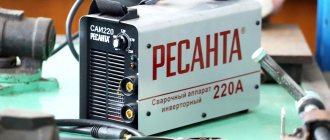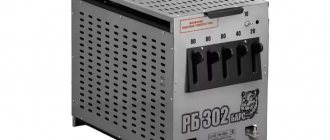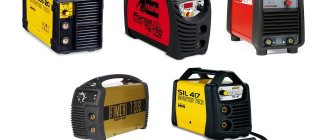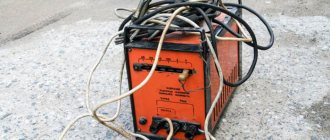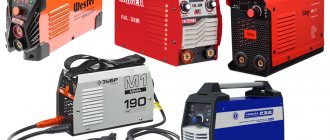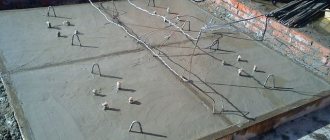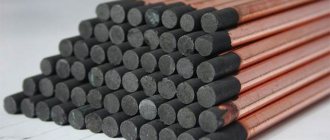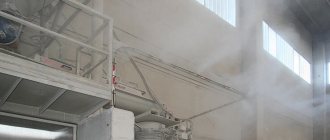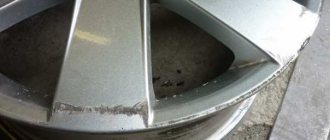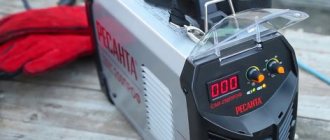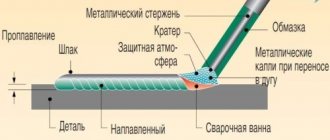Home / Devices
Back
Reading time: 1 minute
0
2863
When choosing a device for welding, we usually pay attention to its technical characteristics and dimensions. However, one must also take into account the conditions in which it will be used. Very often you have to cook in places where there is no access to electricity.
Here, a mobile unit with autonomous power supply will be useful to you. The SAK (wheel welding unit) is excellent for such work.
The wheel welding machine is a current generator, so it is impossible to do without it in places where there is no access to the power grid.
- What is SAC?
- Features of the mobile unit
- Conclusion
general information
A wheeled welding unit (SAK, SAG, mobile/wheeled welding machine, etc.) is a hybrid of a welding machine and a portable power station-generator that generates electric current for welding and cutting. To generate electricity, a diesel internal combustion engine is used, which causes the welding generator to rotate. Afterwards, the generated welding current is supplied to the electrode, and full welding and cutting becomes available to you.
A striking example of SAC is the dy6500lxw electric generator with a welding function with mobile wheels from the Huter brand. Its technical characteristics allow the use of such a device in many areas: from repair to full-fledged production.
In what situations might you need a SAC? When access to electricity is either difficult or completely impossible. For example, during construction on a private country site. Often during the construction process it is possible to obtain only a couple of kW for domestic needs, which is not enough for full welding.
Also, SAC may be needed for on-site welding, when you do not know whether the customer will have access to electricity at the customer’s site. It may be able to provide you with the power you need, but you will never know for sure. And in such situations it is better to insure yourself in advance.
Current model range or what is the best SAC in practice?
Most of the welding units on wheels are a priori manufactured in high quality and with a sufficient level of safety, but you should also not discount the 2%-5% of low-quality assembly and defects.
Those who want to update their equipment come to this idea because of “metal fatigue.” Many still suffer with Soviet assemblies, but 20+ years of operation even for a high-quality unit cannot be considered normal. Below I will tell you about the best SAC models for replacement or as a new purchase.
1) ADD-4004PR
| Expensive | ★★★★ (4.0 out of 5.0) | Overall attractiveness ★★★★★ 5.0 |
| Quality | ★★★★★ (5.0 out of 5.0) | |
| Reviews | ★★★★★ (5.0 out of 5.0) |
A domestically produced unit, which in many respects outperforms foreign suppliers of welding machines on wheels. The fuel for the engine is diesel. In addition to the welding machine, other construction tools can be connected to the SAK through regular sockets.
Advantages of the model:
- Suitable for use in all weather conditions. The temperature range that the SAC can withstand is from -35 to 40;
- easy to use and repair;
- economical fuel consumption;
- mobility and the possibility of autonomous use.
Arc welding can be operated from SAC under direct current. Ampere regulation ranges from 60 to 450 points. A D-144-85 engine with a rotation speed of 1,800 rpm is installed inside. Since the equipment is located in the economy segment, the cooling here is air. Fuel consumption averages 4.5 liters, and the tank itself can hold up to 60 liters of diesel fuel. The dimensions of the unit are 210 X 95 X 120 centimeters, and the weight is 1,200 kilograms.
2) ADD 2x250
| Expensive | ★★★★★ (5.0 out of 5.0) | Overall attractiveness ★★★★★ 5.0 |
| Quality | ★★★★★ (5.0 out of 5.0) | |
| Reviews | ★★★★ (4.0 out of 5.0) |
A more advanced version of the equipment with 2 stations for the use of manual arc welding, cutting and surfacing of metals with direct current. On the Russian market you can find 2 variations of the SAK assembly - air-cooled based on the D-144 engine and water-cooled with the D-243. The cost of the second is 10%-15% higher than the first.
Features of assembly and configuration of the unit:
- The welding generator model SG-2x250 does not have live or rotating parts in its design, which allows the generator to be operated in a temperature range from -40 to +40 degrees Celsius;
- At the output, the generator produces direct current, which is ideal for welding carbon and alloy steels. For grades of medium and high levels of alloying, it will be necessary to use tungsten electrodes in conjunction with a protective environment of argon;
- high level of equipment assembly reliability. For the first 5 years, the unit works like a clock, excluding maintenance;
- high efficiency rate due to an economical and productive diesel engine;
- the presence of an auxiliary generator with a power of 4 kW makes it possible to connect additional lighting for repair work at night. In addition, there is support for 220 volts, which allows you to connect power tools;
- Some suppliers offer to order an oven for drying electrodes as a kit. The last thing is that this is highly specialized equipment upon request, so please check this point in the delivery package in advance.
The rated welding current of the unit is 250 A, and the rated operating voltage is 30 V. In terms of power, the water-cooled SAC is ahead of its air-cooled counterpart - the difference is 31 horsepower. The rotation speed per minute between versions of the equipment also differs - 1800 versus 2200. In terms of dimensions, we get 200 x 95 x 175 centimeters. The mass of the unit with water cooling is 1,100 kg, and with air cooling it is less than 900 kg. There is a version on a trailer with large dimensions and a weight of 1,600 kg.
3) DGW310-2S
| Expensive | ★★★ (3.0 out of 5.0) | Overall attractiveness ★★★★ 4.0 |
| Quality | ★★★★★ (5.0 out of 5.0) | |
| Reviews | ★★★★ (4.0 out of 5.0) |
So we got to foreign types of equipment. SAC DGW310-2S is a unit based on the TAPZ-755 wheeled trailer. The filling is one post from the Japanese company Shindaiwa. Thanks to its convenient trailed design, it is easy to use the SAC even in difficult operating conditions.
What does the “Japanese” offer in terms of characteristics:
- rated welding current 260 A;
- current adjustment can be made in the range 45-310;
- the permissible diameter of the electrode used is from 2.6 to 6 millimeters;
- operating frequency 60 Hz;
- revolutions up to 3,600 per minute;
- no-load voltage up to 85 V;
- there are assemblies for 1 and 3 phases;
- rated output power up to 10 kVA;
- continuous nominal operating mode.
The Kubota D722 engine with a 37-liter tank produces power up to 14/3600 kW per minute. The dimensions of the SAC are 140 x 560 x 770 millimeters, and the dry weight is just over 340 kilograms. The single-axle chassis has a payload of 1.5 tons, and the suspension on semi-elliptical springs, which are connected to the frame by finger springs, can withstand a peak weight of 1.5 times higher than the stated one.
4) Huter DY6500LXW
| Expensive | ★★★★★ (5.0 out of 5.0) | Overall attractiveness ★★★★★ 5.0 |
| Quality | ★★★★★ (5.0 out of 5.0) | |
| Reviews | ★★★★★ (5.0 out of 5.0) |
Electric generators for welding work are needed not only in industrial applications. I consider it quite normal to have such a unit at home. Naturally, spending 500,000+ rubles on such equipment for home use is irrational, so for such purposes, SAKs are purchased at minimal prices. This model is just one of them. “HUTER Electric” GmbH were able to combine mobility, functionality and an adequate price tag, which is considered a priori rare for foreign equipment. The downside for some may be the gasoline engine, but here it comes down to taste and color...
Advantages of using the model:
- convenient to transport and move from place to place thanks to a pair of wheels and handles that fold;
- A manual starter reduces dependence on electronics and allows you to start the engine even in difficult weather conditions. An electric starter is also present here;
- convenient location + assembly of connectors provide tight contact and prevent heating;
- the owner can visually assess the amount of fuel in the tank and fine-tune the output voltage;
- forced engine cooling and economical consumption allow uninterrupted operation for a long period of time;
- high power is contained in the compact dimensions of the device;
- a metal frame will protect the SAC mechanisms from external mechanical influences;
- well suited as a feed for a welding machine.
The model has an active power of 5 kW. Specific fuel consumption is up to 400 grams per kW per hour, and the capacity of the tank itself is 22 liters. In terms of noise level, the SAC produces about 71 dB, but without the muffler that comes with the kit, the value could increase by 2-2.5 times. The weight of the Huter DY6500LXW is only 95 kilograms, and the dimensions are 81 x 52 x 55 centimeters.
What kind of workwear should a welder have?
Brief review of the FORTE petrol SAC:
Peculiarities
The SAC welding machine has a number of features that you need to consider.
Let's start with fuel. As you already understand, SAC is a fuel-powered device. And diesel fuel is often used. It is inexpensive and economical, and its characteristics are sufficient to generate electricity. You can rarely find devices running on gasoline fuel. This is the exception rather than the rule.
Make sure that the SAC model you choose has a built-in cooling system. Thanks to it, the device will work stably and will not let you down at the most inopportune moment. If you buy a SAC without cooling, you will significantly complicate your welding. You will have to constantly monitor the temperature of the device, do not use it longer than indicated in the instructions and worry about the duration of operation. Such a unit needs to constantly cool down, and this is a waste of time.
The components of the device themselves are attached to the frame and covered with a metal casing. Check before purchasing how strong and reliable this frame is and what metal the casing is made of. Do not buy a low-quality device, even if it is offered at a tempting price. Due to a low-quality housing, such a unit simply will not be able to perform all the tasks that you assign to it.
The device you choose must have wheels. Pay attention to them too. They should be durable and have a thick rubber tire. After all, you will not have to move it on asphalt.
Wheeled welding machine (WAM)
When choosing a welding machine, we think about its power, dimensions, technical characteristics and additional functions. But we rarely think about the conditions in which our future welding machine should operate. But the choice of equipment largely depends on this.
If you expect that you will often work without an electrical outlet nearby, then you will need a mobile welding unit, also known as SAC (wheeled welding machine). The SAK welding machine is not just a welding machine. This is a full-fledged generator that can work even in an open field. In this article we will explain in detail what SAC is.
Operating cycle (on period - PV).
The duty cycle (DC) is the period of time during which the welding unit (WAC) can operate at a given welding current without overheating the device. The performance and, indirectly, the service life of the device depend on The duty cycle is indicated as a percentage, indicating that part of the total welding cycle during which the device can operate continuously. That is, if PV = 100%, then there is no need to pause in work. If PV = 50%, then the duration of operation of the device is equal to the duration of “rest”. For example, Shindaiwa welding units have a duty cycle from 60% to 100%, depending on the operating mode, which allows their continuous operation.
Valve type generator circuit
Gasoline generators of this type are made in the form of an inductor three-phase alternating current generator. It has a higher frequency, and the circuit has a built-in rectifier unit. A three-phase AC armature winding is installed on the stator. It is connected according to the “star” or “triangle” scheme. Between the two rotor packages, the excitation winding is also located on the stator.
The rotor itself is made in the form of two packages consisting of gear elements made of electrical steel. It has no windings and rotates around its axis. Each rotor package has eight teeth, offset from each other by 180 degrees.
When a direct current passes through the field winding, an alternating magnetic flux occurs in it. Its distribution is carried out in such a way that the first package creates only the north poles, and the second - the south. When the rotor and stator teeth are aligned, the maximum value of the magnetic flux is achieved, and the amount of resistance along the path of this flux will be minimal. The magnetic flux becomes minimum when the stator tooth coincides with the rotor slot.
Thus, it is clearly seen that the excitation winding is directly involved in the creation of a pulsating or alternating magnetic flux. Penetrating the three-phase stator winding, this flow causes the induction of an alternating emf with an increased frequency in it. In turn, the alternating EMF is converted into a constant voltage of the valve generator using a rectifier unit.
The name of the device is associated with the rectifier unit, which uses silicon valves assembled according to a three-phase circuit in the form of a bridge. The excitation winding is powered through a three-phase generator power circuit. For this, there is a special unit, which includes current and voltage transformers, as well as rectifiers. After starting, the generator is initially self-excited due to the residual magnetic flux.
Collector generators
Design of collector generators
The main elements of a DC welding commutator generator are: a stator with a housing, four main magnetic poles and field windings; an armature with a core in the grooves of which the winding is laid; a collector made of insulated copper plates; four current collection brushes, as well as output clamps.
Rice. 1. Design diagram of a collector generator
The brush-collector device provides a constant EMF of the generator with a variable EMF of individual conductors, performing the function of mechanical rectification of the current.
Independent excitation generator with series demagnetizing winding
In Fig. Figure 1 shows a simplified circuit diagram of the generator. It has only one pair of brushes and one pair of poles. An independent NO winding is wound on one of the poles, receiving power from an external DC source. The demagnetizing winding PR is wound on the other pole, connected in series with the armature and load. Thus, the magnetic flux is created by the combined action of independent and series windings. This, as will be shown below, ensures the formation of a steeply falling external characteristic of the generator. Smooth control of the mode is performed using rheostat R1, rough control is performed by changing the number of turns of the series winding and turning on the ballast rheostat R2.
Rice. 2. Schematic diagram of a generator with independent excitation and series demagnetizing winding
The falling external characteristic of a generator with a series winding is obtained due to its demagnetizing effect.
The mode is regulated: smoothly by changing the current of the independent winding and roughly by sectioning the series winding and turning on the ballast rheostat.
Mobile unit SAK - a modern set of equipment for welding
When purchasing welding equipment for the home, namely for the construction of residential and non-residential buildings, the buyer does not take into account the fact that the welding machine must be connected to something. And if we are talking about a new house under construction, then in the vast majority of cases there is no permission to connect electric current, and using the electrical network without such permission entails significant penalties. There is only one conclusion: the main requirement for technical equipment used in “field” conditions is its complete autonomy, which means complete independence from power sources. If we talk about equipment for welding work, then the ideal option in such cases would be the SAC welding machine. This unit has its own internal combustion engine (ICE).
Using a wheel welding machine at home and in production: features, pros and cons
When choosing a device for welding, we usually pay attention to its technical characteristics and dimensions. However, one must also take into account the conditions in which it will be used. Very often you have to cook in places where there is no access to electricity.
Here, a mobile unit with autonomous power supply will be useful to you. The SAK (wheel welding unit) is excellent for such work.
The wheel welding machine is a current generator, so it is impossible to do without it in places where there is no access to the power grid.
